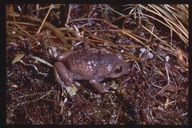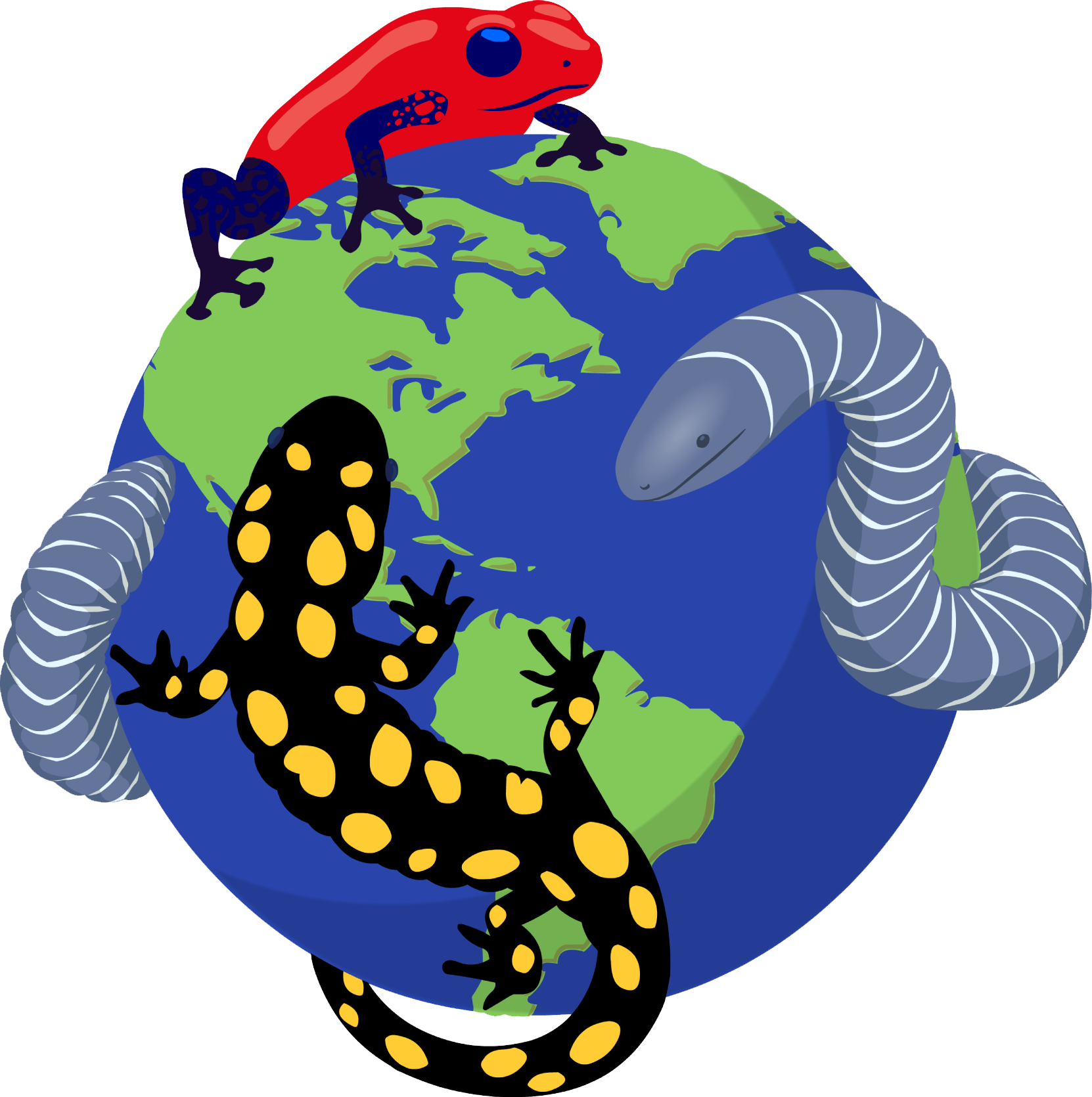|
Holoaden bradei Lutz, 1958
Itatiaia highland frog | family: Strabomantidae genus: Holoaden |
| Species Description: Lutz, B. (1958). Anfibios novos e raros das Serras Costeiras do Brasil (New or rare frogs from the Coastal Ranges of Brazil). Memórias do Instituto Oswaldo Cruz. Rio de Janeiro 56, 372–389 (Portuguese), 389–399 (English). | |
|
Etymology: The honorific epithet, “bradei,” references Alexander Curt Brade, a botanist who worked at the Rio De Janeiro Botanical Garden (Lutz 1958). |
|
 © 1977 Celio Haddad (1 of 1) |
|
|
|
Description The species has glandular skin on the dorsum. Glands appear variable depending on whether they are full or not. When full, they are rounded and elevated. The gular and belly are mainly smooth. The forearms and thighs are less glandular than the rest of the dorsum. The skin usually smooths where the thigh comes into areas of contact with the body and leg, but sometimes the glandular surface continues onto the body and becomes a lateral fold (Lutz 1958). Holoaden bradei have short limbs and thin arms. The hands have two large palmar tubercles, which form a bilobed pad that extends throughout the entire base of the hand, on which there are also some small palmar tubercles. The fingers are short and not webbed, ending in well-shaped narrow, elongated discs. The subarticular tubercles of the fingers are well-developed. The thigh is minimally longer than the tibia but shorter than the foot. The tibiotarsal articulation reaches the shoulder, though it should be noted that in some specimens articulation may extend up to the tympanic area. The hind limb segments are thick, creating a dip in the surface of the thigh where the area folds and meets the leg. The tarsus is also very thick. This species has two metatarsal tubercles and well-developed subarticular tubercles as well (Lutz 1958, Caramaschi and Pombal 2006). Holoaden bradei can be confused for its congenerics, Holoaden luederwaldti, Holoaden pholeter, and Holoaden suarezi. The species can be distinguished from Holoaden luederwaldti by the differences in colorations. Holoaden bradei characteristically has an olive hue in the brown coloration of its dorsum, with black diffused throughout the body irregularly and yellow coloration on the palmar pads, digit tips, and metatarsal tubercles. Additionally, general features like the glandular lumps in the parotoid region and thigh area, the rhomboid shape of the pupils, and thin arms, are more apparent or exaggerated in Holoaden bradei (Lutz 1958). In relation to Holoaden pholeter and Holoaden suarezi, both congenerics have larger body sizes than H. bradei, as well as having uniform dark brown coloration (Martins and Zaher 2013, Pombal et al. 2008). In life, dorsal coloration is recorded to be olive brown, with black diffused onto the ventral body and concentrated at the groin. There is a dark rim around the nictitating membrane. The palmar pads, metatarsal tubercles, and tips of the digits are yellow. The yellow-colored areas fade in death but remain light. In preservative, coloration is preserved well. Ventral coloration is cream. Dorsal coloration is light brown with irregular, sparse dark brown spots (Lutz 1958, Caramaschi and Pombal 2006). Out of the 90 individuals caught in the original species description, the main aspect of variation was the snout-vent length. However, the belly is tesselated in some individuals. The thigh region that touches the side of the body and leg may have a lateral fold that can encircle the belly. There, glandules can be visible below the fold. This was associated with smaller specimens. Lastly, relative hind limb length can also vary (Lutz 1958). Distribution and Habitat Country distribution from AmphibiaWeb's database: Brazil
Life History, Abundance, Activity, and Special Behaviors One female was found to have eight large membrane-less eggs measuring 3 mm in diameter, with large yellow yolks, in the right ovary, and 5 in the left ovary. Additionally, the right ovary contained nine slightly smaller eggs, while the left ovary had 4. Both ovaries also held approximately thirty small, undeveloped eggs (Lutz 1958). This species has direct development. Eggs are laid on the ground between mulch and leaves and are guarded by a parent. When threatened, the parent will hiss and raise itself by the forelimbs (Lutz 1958). Larva Trends and Threats Chytridiomycosis is thought to be the main threat to the species due to positive Batrachochytrium dendrobatidis (Bd) tests found in other species within the region (Carnaval et al. 2006). The species is currently protected under the National Action Plan for the Conservation of Threatened Herpetofauna and its range is encompassed by the Parque Nacional de Itatiaia, which is a protected area (IUCN 2023). Possible reasons for amphibian decline Disease Comments References Carnaval, A. C., Puschendorf, R., Peixoto, O. L., Verdade, V. K., and Rodrigues, M. T. (2006). Amphibian Chytrid fungus broadly distributed in the Brazilian Atlantic Rain Forest. EcoHealth, 3(1), 41–48. [link] Chaves, J. C. M., Hepp, F., Schrago, C. G., and Mello, B.(2024). A time-calibrated phylogeny of the diversification of Holoadeninae frogs. Frontiers in Bioinformatics, 4. [link] IUCN SSC Amphibian Specialist Group and Instituto Boitatá de Etnobiologia e Conservação da Fauna. 2023. Holoaden bradei. The IUCN Red List of Threatened Species 2023: e.T10215A172197685. https://dx.doi.org/10.2305/IUCN.UK.2023-1.RLTS.T10215A172197685.en. Accessed on 10 December 2024. Lutz, B. (1958). Anfibios novos e raros das Serras Costeiras do Brasil (New or rare frogs from the Coastal Ranges of Brazil). Memórias do Instituto Oswaldo Cruz. Rio de Janeiro 56, 372–389 (Portuguese), 389–399 (English). [link] Martins, I. A., and Zaher, H. (2013). A new species of the highland frog genus Holoaden (Amphibia, Strabomantidae) from cloud forests of southeastern Brazil. Zootaxa 3599, 178-188. [link] Pombal Jr., J. P., Siqueira, C. C., Dorigo, T. A., Vrcibradic, D., and Rocha, C. F. D. (2008). A third species of the rare frog genus Holoaden (Terrarana, Strabomantidae) from a montane rainforest area of southeastern Brazil. Zootaxa 1938, 61-68. [link] Originally submitted by: Fede KG (2025-02-10) Description by: Fede KG (updated 2025-02-10)
Distribution by: Fede KG (updated 2025-02-10)
Life history by: Fede KG (updated 2025-02-10)
Larva by: Fede KG (updated 2025-02-10)
Trends and threats by: Fede KG (updated 2025-02-10)
Comments by: Fede KG (updated 2025-02-10)
Edited by: Ann T. Chang (2025-02-10) Species Account Citation: AmphibiaWeb 2025 Holoaden bradei: Itatiaia highland frog <https://amphibiaweb.org/species/2636> University of California, Berkeley, CA, USA. Accessed May 21, 2025.
Feedback or comments about this page.
Citation: AmphibiaWeb. 2025. <https://amphibiaweb.org> University of California, Berkeley, CA, USA. Accessed 21 May 2025. AmphibiaWeb's policy on data use. |




 Map of Life
Map of Life